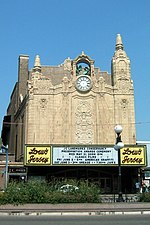26 Journal Square

26 Journal Square is a 55 m (180 ft) high-rise in Jersey City, Hudson County, New Jersey, United States. It was originally known as the Labor Bank Building. It was completed in 1928 and has 15 floors. As of 2009, it was the 23rd tallest building in the city. It is often considered the first skyscraper in Jersey City. The Beaux Arts building was designed by John T. Rowland. It was added to the National Register of Historic Places on June 14, 1984, for its significance in architecture and commerce.The building was originally headquarters of the Labor National Bank. The bank was affiliated with the Branleygran Company, and established by Theodore M. Brandle, a "labor czar" allied with Mayor of Jersey City Frank Hague. Hague channeled construction projects towards the construction bond underwriter, including the Pulaski Skyway. Essentially, Brandle controlled any construction projects in northern New Jersey, and any strikes he might call would be backed by Hague's police.
Excerpt from the Wikipedia article 26 Journal Square (License: CC BY-SA 3.0, Authors, Images).26 Journal Square
Enos Place, Jersey City
Geographical coordinates (GPS) Address Nearby Places Show on map
Geographical coordinates (GPS)
| Latitude | Longitude |
|---|---|
| N 40.730278 ° | E -74.063889 ° |
Address
Hudson County Community College - Building X
Enos Place 26
07306 Jersey City
New Jersey, United States
Open on Google Maps







